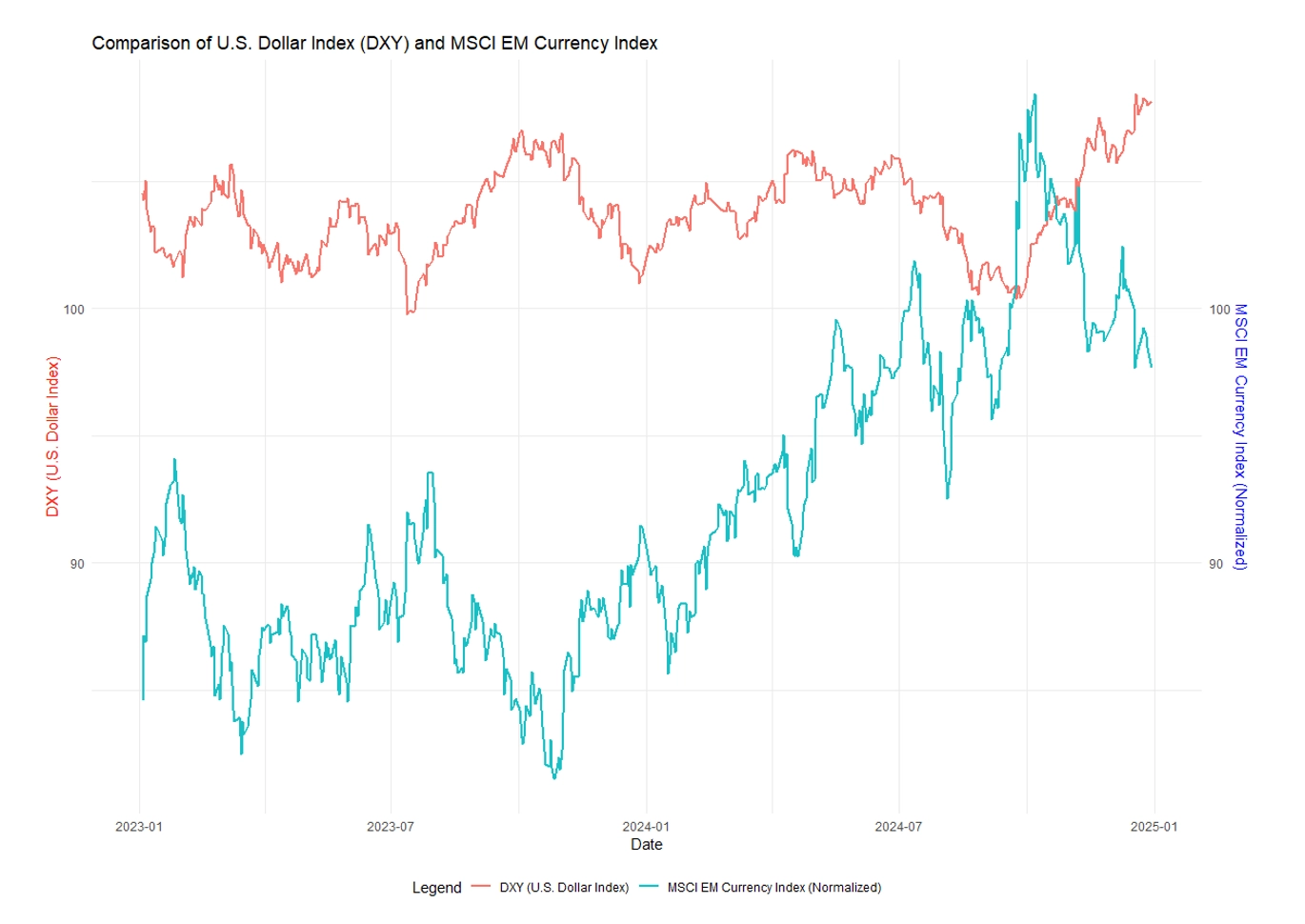
Emerging Market Challenges Amid U.S Dollar Strengths
Through 2024, emerging markets (EMs) navigated the dual challenges of a strengthening U.S. dollar and rising U.S. Treasury yields, which exerted considerable pressure on their economies. The U.S. Federal Reserve's decision to raise interest rates in March and May of 2022, as part of its ongoing strategy to combat inflation, has had far-reaching implications for global financial markets (Trading Economics, 2024). These rate hikes, have bolstered the value of the U.S. dollar, triggering ripple effects across global markets, particularly in EMs. As the dollar appreciates, many EMs—burdened with significant foreign-denominated debt—are confronting higher borrowing costs and increased vulnerability to capital outflows. The figure below highlights the inverse relationship between the U.S. dollar’s strength and the performance of emerging market currencies. As the DXY index rises, emerging market currencies typically weaken, underscoring the mounting challenges these economies face in light of both rising U.S. Treasury yields and a stronger dollar.


How Rising U.S. Rates and a Strengthening Dollar Are Reshaping Emerging Market Economies in 2024
For U.S. consumers, higher interest rates have led to increased borrowing costs for mortgages, car loans, and credit. However, the effects of the Fed's tightening extend far beyond the U.S. borders. A stronger U.S. dollar means that many EM countries, particularly those with substantial dollar-denominated debt, face higher costs to service their external debt. The burden of these debts grows heavier as the dollar appreciates, raising concerns about defaults and financial instability in these economies (Trading Economics, 2024). This, in turn, could trigger broader global financial instability.
A key factor driving this vulnerability is the surge in U.S. Treasury yields. As U.S. bond yields rise, they become more attractive to global investors, leading to capital outflows from riskier EM assets. This shift, compounded by a stronger dollar, exacerbates tightening financial conditions in EMs. At a 20-year high, the U.S. dollar's strength has contributed to a widening gap between U.S. market performance and that of EMs. Many countries are now struggling with capital outflows, inflationary pressures, and rising borrowing costs, which could hinder their ability to manage their economies effectively.
The scale of debt in emerging markets further amplifies these challenges. The Bank for International Settlements (BIS) reports that EMs now hold nearly $30 trillion in debt, accounting for about 28% of the global bond market (BIS, 2024). As borrowing costs rise, the risk of defaults increases, particularly in countries with weak fiscal positions or vulnerable currencies. The strength of the U.S. dollar makes it even more difficult for these nations to manage their external liabilities. In fact, over 60% of government external debt in emerging markets is denominated in U.S. dollars, according to the Financial Stability Board (FSB, 2024). This makes them particularly susceptible to fluctuations in the dollar, which could exacerbate fiscal pressures and lead to further instability.
Moreover, the relationship between U.S. monetary policy and EM performance is complex. While higher interest rates directly impact U.S. consumers and businesses, the strength of the U.S. dollar is the primary driver of economic outcomes in many emerging markets. As these economies face challenges such as fiscal imbalances, weaker currencies, and geopolitical instability, their ability to adapt to shifting global conditions will be crucial.
There are two major concerns for emerging markets considering the current economic landscape:
- Capital Outflows: As U.S. Treasury bonds become more attractive due to higher yields, capital that was previously invested in emerging markets may flow back to the safety of U.S. assets. This could lead to tighter financial conditions in EMs, especially those that rely heavily on foreign investment for growth.
- Increased Borrowing Costs: The rising strength of the U.S. dollar, combined with higher interest rates, makes it more expensive for emerging market governments and businesses to secure financing. Many of these countries rely on foreign-denominated debt, and higher interest rates increase the cost of servicing this debt, exacerbating existing economic vulnerabilities.
Christine Lagarde, Managing Director of the International Monetary Fund (IMF), has warned of the "spillover" effects of U.S. monetary tightening on emerging markets. She has emphasized that the ongoing rate hikes could increase volatility in financial markets, particularly in EMs, which are more sensitive to global economic shifts (IMF, 2024). The IMF’s warning underscores the broader risks posed by the U.S. Federal Reserve’s policies, which could contribute to instability in already fragile economies.


Additionally, several global factors are complicating the outlook for emerging markets. High oil prices, a slow recovery in China, and geopolitical instability in the Middle East have further strained these economies. While the Bloomberg Emerging Markets Capital Flow Proxy Index—tracking capital flows into and out of EMs—has not yet raised major concerns, the Citi Emerging Markets Macro Risk Index has shown an increase in investor perceptions of risk, which could further amplify capital outflows (Bloomberg, 2024). Historically, a higher perception of macroeconomic risk correlates strongly with outflows, suggesting that EMs may face increasing challenges if their economic conditions continue to deteriorate.


By analysing historical data with tools like Stata, analysts can quantify the impact of rate hikes and dollar appreciation on EM growth, inflation, and financial stability. Stata’s advanced data analysis capabilities provide a valuable framework for forecasting the potential consequences of these global economic shifts, allowing policymakers and investors to make more informed, data-driven decisions.
Conclusion
In conclusion, as the global economic environment continues to evolve, emerging markets face significant risks from the dual pressures of rising interest rates and a strengthening U.S. dollar. To mitigate these risks, EMs must adopt comprehensive strategies, such as diversifying financing sources, strengthening domestic financial systems, and improving foreign currency reserve management. However, the road ahead remains uncertain, and the ability of these markets to navigate these challenges will be critical in avoiding financial instability.
For investors, understanding these risks and leveraging tools like Stata for data analysis and econometric modelling will be key to making informed decisions in an increasingly complex global financial landscape.


Francisca Carvalho, Lancaster University
Francisca is a third-year PhD student in Economics at Lancaster University. Her research focuses on climate risk factors and their impact on portfolio returns. She also teaches mathematics, econometrics, macroeconomics and microeconomics, to undergraduate and postgraduate students.
- Bank for International Settlements. (2024). Debt in emerging markets reaches $30 trillion. Retrieved from BIS Website.
- Bloomberg. (2024). Emerging Markets Capital Flow Proxy Index: Tracking financial flows. Retrieved from Bloomberg Website.
- Financial Stability Board. (2024). Emerging markets' external debt denominated in U.S. dollars. Retrieved from FSB Website.
- International Monetary Fund. (2024). Spillover effects of U.S. monetary policy on emerging markets. Retrieved from IMF Website.
- Trading Economics. (2024). United States Dollar – Federal Reserve Interest Rate Hikes. Retrieved from Trading Economics Website.












